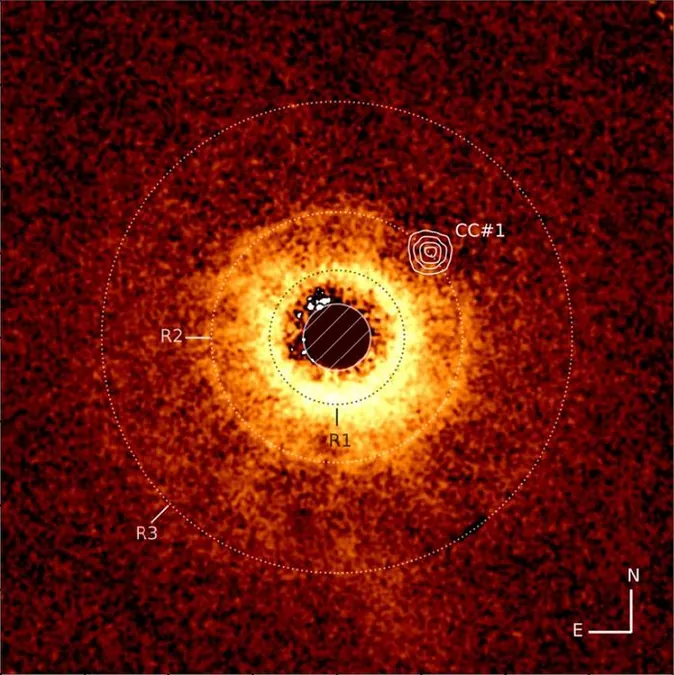
Astronomers Unveil Hidden Exoplanet with Groundbreaking James Webb Space Telescope
2025-07-08
Author: Jacob
A Cosmic Milestone: The Discovery of TWA 7 b
In a monumental leap for space exploration, the James Webb Space Telescope (JWST) has successfully captured direct images of an exoplanet previously unseen by human eyes. This groundbreaking achievement opens new doors to uncovering distant, small, and cold worlds beyond our Solar System.
Unveiling the Secrets of Exoplanetary Systems
For years, scientists have been on a relentless quest to identify exoplanets—planets that orbit stars outside our Sun. By studying these celestial objects, researchers gain vital insights into the formation and evolution of planetary systems. Although thousands of exoplanets have been discovered through indirect detection methods, capturing direct images remains exceedingly rare due to the overwhelming brightness of their stars.
However, researchers at the Observatoire de Paris-PSL, in partnership with Université Grenoble Alpes, have found a way to overcome this hurdle. They ingeniously attached a coronagraph to the MIRI instrument onboard JWST. This high-tech device acts much like the Moon during a solar eclipse, blocking out the star’s light and allowing faint celestial bodies to be observed.
Spotting the Hidden Gem: TWA 7 b
Published in the prestigious journal Nature, the team has discovered a new exoplanet named TWA 7 b, nestled within a disk of rocky debris and cosmic dust. This is not just another exoplanet; it is the first direct imaging discovery made by JWST.
The Evolutionary Playground: Debris Disks
Most planets are born from swirling dust and gas around young stars. As time progresses, gas dissipates, leaving a debris disk of rocky fragments that can persist for millions to billions of years. These disks often exhibit intriguing structures—like rings and gaps—that hint at the gravitational influence of unseen planets.
The star TWA 7 lies approximately 34 parsecs away and is relatively young at just 6.4 million years. Its disk showcases three significant rings from a bird's-eye view. The innermost ring orbits at 28 astronomical units from its star, with a narrow ring at 52 AU and a broad outer ring extending to 93 AU.
A Breakthrough Observation
On June 21, 2024, JWST captured stunning coronagraphic images of TWA 7 using the F1140C filter, specifically designed to observe at a wavelength of 11.3 microns. By contrasting these images with reference stars to mitigate light distortions, the research team uncovered three bright spots near TWA 7.
Among these, one was a known background star, another appeared to be a distant galaxy, but the third—located 1.5 arcseconds northwest of TWA 7—was something special. Its placement correlated precisely with the narrow ring at 52 AU and had no prior data association, raising suspicion that this could be the elusive new exoplanet.
Confirming the Exoplanet Existence
Extensive analysis ruled out the possibility of it being a Solar System object or background star, as its lack of movement during a two-hour exposure was inconsistent with known distant bodies. In fact, the likelihood that this was a distant galaxy was only 0.34%, further bolstering the case for it being a planet.
Using the HADES model for studying planetary atmospheres, scientists estimated TWA 7 b's temperature to range between 305 and 335 Kelvin, with a mass approximately 0.3 times that of Jupiter—similar to Saturn. This models predictably created a thin ring and void in precise alignments with observations, confirming its identity as TWA 7 b.
A New Era of Exoplanet Research
The discovery of TWA 7 b is revolutionary, representing a lighter and colder exoplanet than any previously seen through direct imaging. Its low temperature makes it an exceptional target for studying non-irradiated gas planets, providing a unique opportunity to compare atmospheres against giants like Jupiter or the colder worlds like ep. Ind Ab.
JWST's mid-infrared capabilities and the innovative coronagraph played a pivotal role in unveiling this hidden gem. This advancement underscores the importance of cutting-edge tools in astronomy. Without them, faint signals such as TWA 7 b's glow could have remained concealed.
As scientists look ahead, they believe JWST might reveal even smaller exoplanets in the future—potentially those with merely 10% of Jupiter's mass. This discovery not only proves the telescope's potential but also paves the way for future explorations into exoplanetary systems that may resemble Earth more closely.
In the words of the research team, this is merely the beginning. The path is now clear for the discovery of more small, cold planets, bringing us closer to answering fundamental questions about our own origins.









 Brasil (PT)
Brasil (PT)
 Canada (EN)
Canada (EN)
 Chile (ES)
Chile (ES)
 Česko (CS)
Česko (CS)
 대한민국 (KO)
대한민국 (KO)
 España (ES)
España (ES)
 France (FR)
France (FR)
 Hong Kong (EN)
Hong Kong (EN)
 Italia (IT)
Italia (IT)
 日本 (JA)
日本 (JA)
 Magyarország (HU)
Magyarország (HU)
 Norge (NO)
Norge (NO)
 Polska (PL)
Polska (PL)
 Schweiz (DE)
Schweiz (DE)
 Singapore (EN)
Singapore (EN)
 Sverige (SV)
Sverige (SV)
 Suomi (FI)
Suomi (FI)
 Türkiye (TR)
Türkiye (TR)
 الإمارات العربية المتحدة (AR)
الإمارات العربية المتحدة (AR)